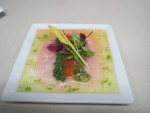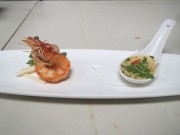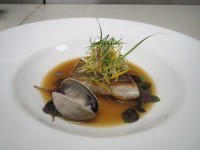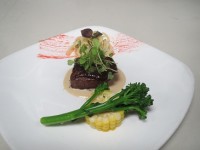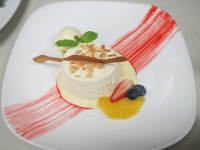“NEW AGE” KAISEKI MENU
JANUARY 28, 2014
first course
Mekajiki Carpaccio–sesame oil-chive relish, chili pepper water vinaigrette, micro greens and truffle oil
wine: Birichino Malvasia Bianca 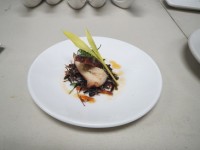
second course
Braised Island Tako–seaweed salad, yuzukoshu, shiso and yuzu vinaigrette
wine: Gysler Silvaner Medium Dry 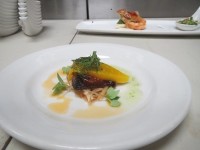
third course
Marinated Island Papaya & Seared Foie Gras–green papaya, sweet Thai chili and Thai basil chiffonade
fourth course
“Surf and Turf”
oxtail chawan mushi spoon & Kauai shrimp with Chinese five spice dust
Crispy Skin Kampachi–saffron- kaffir lime broth, crab salad, Manila clam and micro shiso and lemongrass
wine: Domaine Skouras “Zoe”
sixth course
“Mapo Pork & Pork Tofu”–Shinsato Farms Pork shoulder, local wild pig and Mrs. Cheng’s tofu
wine: CF Euro-Asian Riesling Medium Dry
Sous Vide of Kulana Beef —miso glaze, yukari, pickled wasabi tops-cauliflower puree, roasted vegetables & scallion pesto pasta
wine: Chateau Fontanes “Coteaux du Languedoc”
eighth course
Pepper Seared Ahi Chazuke-ikura, house made tsukemono and truffled green tea broth
Kaffir Lime Lemongrass Bavarois–coconut anglaise, pineapple sorbet & Surinam cherry streak
WINES
One of the things I have learned more & more about over the years is understanding, when pairing wines with foods, is the window of opportunity is much bigger, when one approaches with wines more “country-ish” is style. Meaning, we don’t need lots of alcohol, we don’t need lots of oak, or declassified Auslese. What we need is for the wines to be delicious, lighter bodied, well balanced & gulpable. Save the trophy wines for another day.
In the case of dealing with Asian inspired foods, we have to adjust even more. Fruit, fruit, fruit…..lightness….lower, more moderate alcohol & UN-oaky, UN-bitter.
With that spirit in mind, here are the pairings for this Kaiseki.
Birichino Malvasia Bianca–A VERY aromatic, DRY, amazingly light bodied, wonderfully food friendly white wine.
GRAPE: Malvasia
ORIGIN: Monterey
WINEMAKER: John Locke (former, long time winemaker at Bonny Doon)
We have found such aromatic grape varieties really connect with the herbs in dishes like this. BOTH highly brighten a dish. This version also has a distinct lime-edge to it which keep the palate alive & fresh with each bite.
Gysler Silvaner Medium Dry
GRAPE: Silvaner
ORIGIN: Rheinhessen (red sandstone—converting to biodynamic farming)
WINEMAKER: Alexander Gysler
The octopus dish has slight sweetness, saltiness & a subtle pinch of heat, which is why we needed some residual sweetness in the wine in addition to lower alcohol in the finish. Another important factor to consider….is this style is much more light & “country” ish….rather than being beefed up with declassified Spatlese or Auslese, which some people say is because of Global Warming & the regularity of warm vintages & ripe grapes. We didn’t need star power for this dish, just food friendliness
Elio Perrone Bigaro
GRAPE: Brachetto & Moscato
ORIGIN: Piemonte
WINEMAKER: Stefano Perrone
Because this is a foie gras dish, we felt we needed some sweetness to the pairing. In the old days, people looked to French Sauternes. For me, that is like 2 Sumo wrestlers going at it. How would one follow such a pairing? Here is a fruity wine, which is an innovative blend of Brachetto (red) & Moscato (white), which would be like fresh fruit with the foie gras.
Domaine Skouras “Zoe”
GRAPE: Roditis & Moschofilero
ORIGIN: Nemea, Peloponnese, Greece
WINEMAKER: George Skouras
Here is yet another wonderfully aromatic “country” styled white wine. George Skouiras is Burgundy trained & is leading the charge in Greece to contemporize the wine movement in his country. In this case, he combines 2 indigenous grape varieties which he ferments in stainless steel to retain the aromatics (jasmine & mint nuances) & innate liveliness of the wine—to create something light, delicious & gulpable…..ideal with fish & seafood dishes.
CF Euro-Asian Riesling Medium Dry
GRAPE: Riesling
ORIGIN: Rheinhessen (red slate soils)
WINEMAKER: Fritz Hasselbach
This is a collaborative wine project with Fritz Hasselbach of Gunderloch. In the beginning, Fritz would send me bottles of different cuvees, & I would make a blend while sitting at the bar & using a jigger. I would then forward the “recipe” back to him. The different lots were from his 3 main top echelon vineyard holdings—Nackenheimer Rothenberg, Niersteiner Pettenthal & Niersteiner Hipping. The blend would change every year. After, we got into a groove, there was no need to go back & forth, as Fritz would just send me a bottle of what he knew we were looking for. Because of a very long string of warm vintages, however, the wines started rising in bitterness & alcohol levels. Last year, Cheryle & I returned to look at adjusting the recipe. For the 2011, Fritz allowed us to belend in 15% Auslese (7.5 alcohol) to balance it better. For 2012, we asked if he would raise the yields. The bottom line…..the wines have never been better. This wine with the food, would be like biting into a cold pineapple, which would counter the heat or saltiness while cooling & soothing the palate between bites.
Chateau Fontanes “Coteaux du Languedoc”
GRAPE: 40% Syrah, 20% Grenache, 20% Mourvedre, 10% Cinsault & 10% Carignane
ORIGIN: Pic St Loup, Languedoc
WINEMAKER: Cyriaque Rozier
Because this meat dish has some oriental-ness to it, we did NOT want a heavy red, nor one with much oak, alcohol & grand-ness. The wine had to have flavor & intensity without showiness. We also want to serve this wine cool (65 to 70 degrees).
We first met Cyriaque at his day job, running Chateau La Roque. Cheryle & I just fell in love with this young couple, their 2 kids & their vision of wine. “Rozier first started his domaine in 2003, and undertook the ultimate labor of love in the Languedoc—planting a vineyard. For many years, this plot of land was best known for olive trees, until the great frost of 1956 decimated groves by the hundreds. The land is hard as a rock, quite literally, and composed primarily of limestone and clay. To plant a vineyard here is a game of patience and incredibly hard work. Over the last few years, Cyriaque has been slowly building stone terraces to better protect this challenging terrain from erosion. In addition, he has taken to farming biodynamically, a noble task that forgoes the shortcuts that most vignerons have at their disposal today in favor of producing organic grapes in a rich, healthy soil. In total, he works 4.5 hectares, which are planted with forty-year-old Cabernet Sauvignon vines, as well as Syrah, Grenache, Mourvèdre, Carignan and Cinsault. He cannot help but love his plantings, as the original cuttings for his vines were all selected from his favorite domaines in Côte-Rôtie, Châteauneuf-du-Pape, and Bandol.
Being rebellious seems to come naturally to a man of such innate talent, and the elegance of his wines are proof enough in a region where bigger is often considered better. Make no mistake, raw terroir and spicy garrigue abound in these wines, with rich, juicy fruit and silky tannins”.
